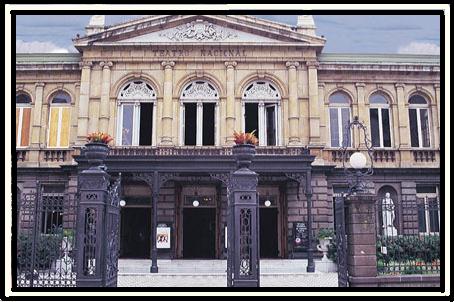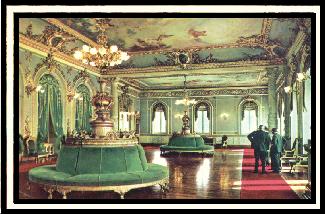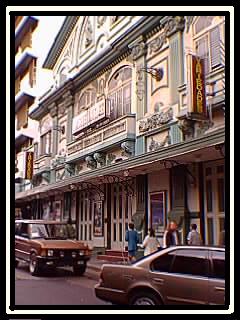 
 
 
 
 
 
 
 
 
 
 
 
 
 
 
 
 
 
 
 
 
|
 |
THEATERS AND CINEMAS
Costa Rica in 1960`s was the only Central American country with theater.
Theater Melico Salazar -[Av.2/calle Central]. One of two the most known theaters in Costa Rica. It is in front of the Central Park.  It was
built in 1799 and served at the beginning as the municipal tenement-house. On
that time the park on which it stood was called Plaza Real. In 1828 it was
destroyed by earthguake and rebuilt from stone elements. It was
built in 1799 and served at the beginning as the municipal tenement-house. On
that time the park on which it stood was called Plaza Real. In 1828 it was
destroyed by earthguake and rebuilt from stone elements.
During terms of Juan Rafael Mora, it was converted into his
main office. In 1849 Mora moved there his new army. There were the ammunition,
cannons and guns. The traces of that were being finding many years after that (the cannons hiden beneath the floor have been found in one of the
rooms).
On July 18th of 1918, the building again changed its
functions and became the school for boys. In 1924 the earthquake seriously
damaged its construction, and the school became empty. A few years later after
romoving the ruins, the new owner of that surface was Jose Raventos. He wanted
to build the theater, that could rival with National Theater. The new building
was designed by Costa Rica architect. On putting up the building (7.X.1928) with
2250 seats, was called the Raventos Theater. The first operetta that was played
was titled "Kiss me", and the title role belonged to Esperanza Iris. In
subsiguent years the  first silent films started to be produced. The good luck
for theater ended in 1967, when during stage adaptation of "Dracula", the fire
destroyed its interior. first silent films started to be produced. The good luck
for theater ended in 1967, when during stage adaptation of "Dracula", the fire
destroyed its interior.
In 1970`s, the cultural
elite of San Jose bought and renovated it giving the name of "the Popular
Theater". The renovation ended up in 1976 and soon after that the quarrel about
its name started again. Some people wanted to call it just The Municipal
Theater. Others suggested to change it for Melico Salazar Theater (famous Costa
Rica tenor). The latter idea won and since 1980 it has been called that way.
During renovation, workers from spanish Museum of Art added the third floor, rebuilt the stage, the dais for orchestra, strengthen Corinthian columns,
balconies and completed many reliefs. The number of seats was reduced to 1000.
The velvet curtains have been brought from Spain. On 13 December of 1981, the
theater started to functione again, producing a performance called "the
Carmen". The theater season lasts from April to December.
Theater Nacional -[Av.2/calle 3-5]. It`s situated in the south-west corner of the Culture
Square. Its building was initiated at the end of XIX century by coffee barons,
who agreed for special tax from each coffee bag.  It was because the world famous
prima donna Adelina Patti during her tournee through Central America, overlooked
Costa Rica due to the lack of proper place for performing. The building was
designed by architects from Italy, Spain and France. It was built from steel
frames protecting it against the earthquakes. Finally, the building was ended up
in 1897. In 1965 it was declared the national monument. In 1991 the renovation
of that was carried out. It was because the world famous
prima donna Adelina Patti during her tournee through Central America, overlooked
Costa Rica due to the lack of proper place for performing. The building was
designed by architects from Italy, Spain and France. It was built from steel
frames protecting it against the earthquakes. Finally, the building was ended up
in 1897. In 1965 it was declared the national monument. In 1991 the renovation
of that was carried out.
It`s made of sandstone and is a scaled-down of Paris opera.
It`s accentuated by arched windows and columned facade (the columns are made
of marble brought from Italy). The entrance to the theater is flanked by
figures of Bethoven and Spanish dramatist Calderon de la Barca. Three other
figures symbolizing of Music, Art and Literature, are put on  triangular top. The
whole is covered by domed roof. The interior is destinguished by sumptuous hall, marble
steps, golden and bronze finishes, tropical woods, crystallic chandeliars,
mirrors and picture. On the ceiling, there is a fresco featuring the banana
loading for boat, painted by Arturo Fontana. On the second level is a ceiling painting by Italian artists Aleandro Villa, entitled Alegoria. In the theater rooms, there is a cafe Ruisenor offering
coffee, sandwiches and cakes. triangular top. The
whole is covered by domed roof. The interior is destinguished by sumptuous hall, marble
steps, golden and bronze finishes, tropical woods, crystallic chandeliars,
mirrors and picture. On the ceiling, there is a fresco featuring the banana
loading for boat, painted by Arturo Fontana. On the second level is a ceiling painting by Italian artists Aleandro Villa, entitled Alegoria. In the theater rooms, there is a cafe Ruisenor offering
coffee, sandwiches and cakes.
Theater of Eugene O`Neill -The third largest theater in Costa Rica. It hosts Costa Rican performing arts, as well as from the United States and from other cultures. It has 314 seats.
Cinema of Variedades -[Av. Central-1/calle 5]. The most known cinema in San Jose. It was founded by a trademan Tomas Garcia in 1891. At the
beginning there performed  the wandering groups. The popularity it gained after
the municipal theater was burned out (today`s Melico Salazar Theater) in 1960`s.
It`s designed for 185 viewers. Its name has to do with different artistic events
taking place on there (from circus through sorcerers shows to cinema). It has
nonchanged facade from the beginning. In 1930, there was shown the first ever in Costa Rica history movie "El Retorno" (that was brought by Don Amando). It`s specialized with showing vanguard
films. Annually in there is held the Festival of Costa Rican Movies. In 1904 the Greco company organized there the first cinematographic projection on french Lumiere engine. In 1909 there was chosen a candidate for Republican Party Ricardo Jimenez. the wandering groups. The popularity it gained after
the municipal theater was burned out (today`s Melico Salazar Theater) in 1960`s.
It`s designed for 185 viewers. Its name has to do with different artistic events
taking place on there (from circus through sorcerers shows to cinema). It has
nonchanged facade from the beginning. In 1930, there was shown the first ever in Costa Rica history movie "El Retorno" (that was brought by Don Amando). It`s specialized with showing vanguard
films. Annually in there is held the Festival of Costa Rican Movies. In 1904 the Greco company organized there the first cinematographic projection on french Lumiere engine. In 1909 there was chosen a candidate for Republican Party Ricardo Jimenez.
Great Libanon Cinema -[Av.7/calle 8]. It`s a decaying example of the art deco style which led the way to modern architecture with its rectilinear decoration and cement work.
If you have any questions, feel free to write to the owner of the page Rafal C. Piechocinski
and visit also the biggest web-page about Costa Rica in Europe at http://www.kostaryka.org/central2489.
|